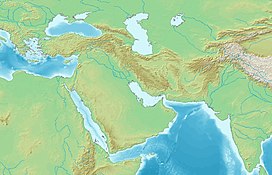TheAsir Mountains[1](Arabic:جِبَال عَسِيْر,jibāl ʿasīr;Arabic pronunciation:[d͡ʒɪbaːlʕasiːr]('Difficult')) is a mountainous region in southwesternSaudi Arabiarunning parallel to theRed Sea.It comprises areas in theRegion of 'Asir,but generally, it also includes areas near theborderwithYemen.The mountains cover approximately 100,000 square kilometres (40,000 sq mi) and consists ofmountains,plains, and valleys of the Arabian highlands.[2]Sensu lato,they are part of theSarawat Mountains,[3]defining the latter as the mountain range which runs parallel to theTihamahthroughout the western portion of theArabian Peninsula,particularly the western parts of Saudi Arabia and Yemen.[4][5][6]
| Asir Mountains | |
|---|---|
 A rocky mountain in the range | |
| Naming | |
| Native name | جِبَال عَسِيْر(Arabic) |
| Geography | |
| Country | |
| Region | Arabian Peninsula |
| Range coordinates | 21°36′N39°48′E/ 21.6°N 39.8°E |
Geology
editThe mountains consist primarily of sedimentary rock,limestone,sandstoneandshale,ofJurassic,CretaceousandPaleogeneorigin on aPrecambriangraniticbasement.[2]
Climate and agriculture
editThe region has the highest average rainfall ofSaudi Arabia[citation needed]due to largely seasonal rain. Average rainfall can range from 600 millimetres (24 in) to over 1,000 millimetres (39 in) per year, in wet regions. The eastern plains and plateaus receive much lower amounts, from 500 millimetres (20 in) to below 100 millimetres (3.9 in) per year.[2]
The region's crops, most of which are cultivated on steeply terraced mountainsides, includewheat,coffee,cotton,indigo,ginger,vegetables,andpalms.The region also supportscattle,sheep,goats,andcamels.[citation needed]
Biodiversity
editThe region's difficult terrain has helped preserve the region's unique biodiversity. Several newMyxomycetesfungi species have been discovered in the region, as have a variety of previously undiscovered plants.[7]Asir is also thought to be one of the last natural habitats of theArabian leopard.[2][5][6]and also theAsir magpie,believed to be down to its last 135 pairs.[8]
Gallery
edit-
Jabal Sawdah( "Mount Sawdah" )
-
AbhaCity, located 2,270 m (7,450 ft) above sea level in the'Asir Region
-
HabalahValley near Abha
-
Jabal Atherb,as seen from Ḥawālah inBareq
See also
editReferences
edit- ^"Library of Congress Country Study: Saudi Arabia",TheLibrary of Congress,archived fromthe originalon 2008-09-23
- ^abcd"Southwestern Arabian montane woodlands".Terrestrial Ecoregions.World Wildlife Fund.
- ^Overstreet, William Courtney (1977).Tertiary laterite of the As Sarat Mountains, Asir Province, Kingdom of Saudi Arabia.Vol. 2. Directorate General of Mineral Resources. pp. iii–2.
- ^Nasr, Seyyed Hossein(2013). "1: The Holiest Cities of Islam".Mecca the Blessed, Medina the Radiant: The Holiest Cities of Islam.Tuttle Publishing.ISBN978-1-4629-1365-7.
- ^abJudas, J.; Paillat, P.; Khoja, A.; Boug, A. (2006)."Status of the Arabian leopard in Saudi Arabia"(PDF).Cat News.Special Issue 1: 11–19.
- ^abSpalton, J. A. & Al-Hikmani, H. M. (2006)."The Leopard in the Arabian Peninsula – Distribution and Subspecies Status"(PDF).Cat News(Special Issue 1): 4–8. Archived from the original on May 23, 2011.
{{cite journal}}:CS1 maint: unfit URL (link) - ^Boulos, L. (1985),"Myxomycetes from the Asir Mountains, Saudi Arabia (abstract)",A contribution of the flora of the Asir Mountains, Saudi Arabia,vol. 3, Arab Gulf Journal of Scientific Research, pp. 67–94, archived fromthe originalon February 29, 2012
- ^"Protecting the Asir Magpie".


